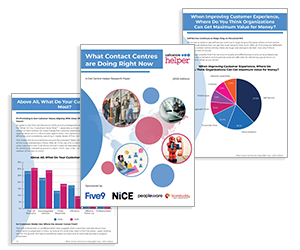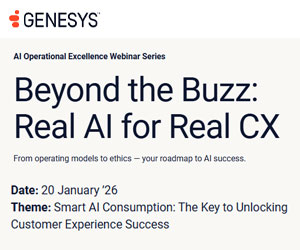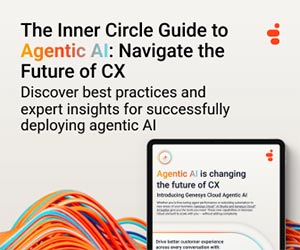Abhijit Salv at Five9 explores how modern contact centres can move beyond legacy quality management practices to adopt outcome-focused approaches that combine automation, intelligence, and human insight.
The contact centre is no longer a place where human effort alone can keep pace. Every day, agents manage thousands of interactions across voice, chat, social, and video. Customers expect each of those touchpoints to be seamless, personalized, and outcome-driven.
Traditional quality assurance, built on manually sampling 1-3% of calls, wasn’t designed for this reality. It creates blind spots that cost businesses millions – missed opportunities to build loyalty, and missed warning signs of churn or dissatisfaction.
What’s breaking down isn’t just the tools, but the philosophy: measuring compliance with processes rather than the outcomes that truly matter – customer satisfaction, agent empowerment, and business results.
Today’s contact centres need a new approach, one that goes beyond human limitations and embraces automation, intelligence, and scale.
As consumers increasingly expect to connect through their channel of choice, whether that is voice, chat, social, video, or email, accurately capturing both customer satisfaction and agent performance across every interaction is more important than ever.
The Challenges With Traditional Contact Centre Quality Management
Gone are the days of recording a few calls and manually reviewing them for quality assurance (or, at least they should be). Today, the sheer volume and variety of interactions make it impossible to rely on traditional methods.
Customers expect the businesses they interact with to know who they are and to deliver consistent, personalized service l.
And, these exacting standards directly correlate to their willingness to shop with that business again. In fact, 94% of consumers are inclined to make repeat purchases following a positive customer service experience.
Meeting that standard requires processing vast amounts of unstructured data and connecting identities seamlessly across channels, a tall order without the right systems in place.
Compounding this challenge is the increasing complexity of quality management (QM) products. Many rely on third-party integrations that introduce latency, create maintenance headaches, and slow time to value.
When we speak with customers, they consistently share that they’re on a journey toward vendor consolidation, seeking platforms that deliver faster outcomes, minimal integration requirements, and fewer points of failure.
At the same time, mounting skills shortages make it harder to expand teams quickly enough to keep up with demand.
In Five9’s recent report, they found that 55% of business leaders surveyed said that agents increasingly need more emotional intelligence and empathy to appropriately handle interactions.
These challenges expose the limits of legacy quality management tools and highlight why it’s time for a fundamentally new approach.
The New Contact Centre Quality Management Best Practices
To raise the bar in your contact centre and meet your customers where they are, you must evolve your approach to contact centre quality management.
Forward-looking organizations are evolving from compliance-driven monitoring to outcome-focused quality management.
Before you can take the steps to successfully monitor quality, it’s important to have the proper foundation. Instead of asking “did the agent follow the script?” the real measure is “did the customer leave satisfied, and will they return?”
Here’s how you make that shift:
Monitor and Evaluate Every Interaction
First things first, ditch the idea that evaluating only a fraction of interactions is enough. Accuracy in decision-making depends on visibility. The more conversations you can review, the more actionable your insights will be.
Don’t worry, good quality management software makes this far easier than trying to use traditional quality management tools.
Modern contact centre quality management software automatically captures agent interactions across every channel, complete with recordings and transcripts that scale far beyond what humans could review manually.
Provide Agents With Real-Time Assistance and Coaching
Quality management shouldn’t only be retrospective. Rectifying a problem after it’s happened is all well and good, but preventing agent missteps during customer engagements is far better.
By embedding live coaching and contextual guidance into interactions, supervisors can help agents avoid missteps before they happen. This approach transforms quality from a policing function into a driver of continuous improvement.
Embed Quality Management Throughout Your Contact Centre
Consistency is key, and part of good contact centre quality management is ensuring every customer interaction is up to par.
Rather than limit your quality assurance practices to a single system, integrating it into key systems – such as your CRM, routing algorithm, or real-time agent assist rules – everyone who touches the customer experience works from the same foundation of feedback and insights.
This turns quality management into an organization-wide discipline that improves satisfaction and retention at scale.
How to Improve Your Contact Centre Quality Management
Relying on legacy quality management tools means settling for blind spots and inefficiencies in your contact centre. Best-of-breed solutions eliminate those gaps and enable leaders to improve experiences in real time – for both customers and employees.
The future of contact centre quality management won’t be won by bigger teams listening to more recordings.
It will be defined by organizations that reimagine quality as a continuous, outcome-based discipline — embedded across every system, every channel, and every interaction.
As contact centres evolve, so will the workforce itself. The next era of customer engagement will blend human and AI agents, working together to deliver faster, more personalized service.
This shift will require quality management software that can evaluate both, ensuring that human empathy and AI precision combine to create seamless customer experiences.
By moving past legacy sampling and process-checking, and instead using modern tools that capture and analyse every interaction, leaders can finally close the gap between what customers expect and what agents (whether human or AI) can deliver.
The result isn’t just fewer blind spots. It’s a stronger, smarter contact centre. One that thrives precisely because it has moved beyond human limitations.
For more information about Five9 - visit the Five9 Website
Call Centre Helper is not responsible for the content of these guest blog posts. The opinions expressed in this article are those of the author, and do not necessarily reflect those of Call Centre Helper.
Author: Five9
Reviewed by: Rachael Trickey
Published On: 24th Nov 2025
Read more about - Guest Blogs, Five9






 Five9 empowers organizations to create hyper-personalized and effortless AI-driven customer experiences that deliver better business outcomes. Powered by Five9 Genius AI and our people, the Five9 Intelligent CX Platform is trusted by 3,000+ customers and 1,400+ partners globally. The New CX starts here and it's at the heart of every winning experience.
Five9 empowers organizations to create hyper-personalized and effortless AI-driven customer experiences that deliver better business outcomes. Powered by Five9 Genius AI and our people, the Five9 Intelligent CX Platform is trusted by 3,000+ customers and 1,400+ partners globally. The New CX starts here and it's at the heart of every winning experience. 































